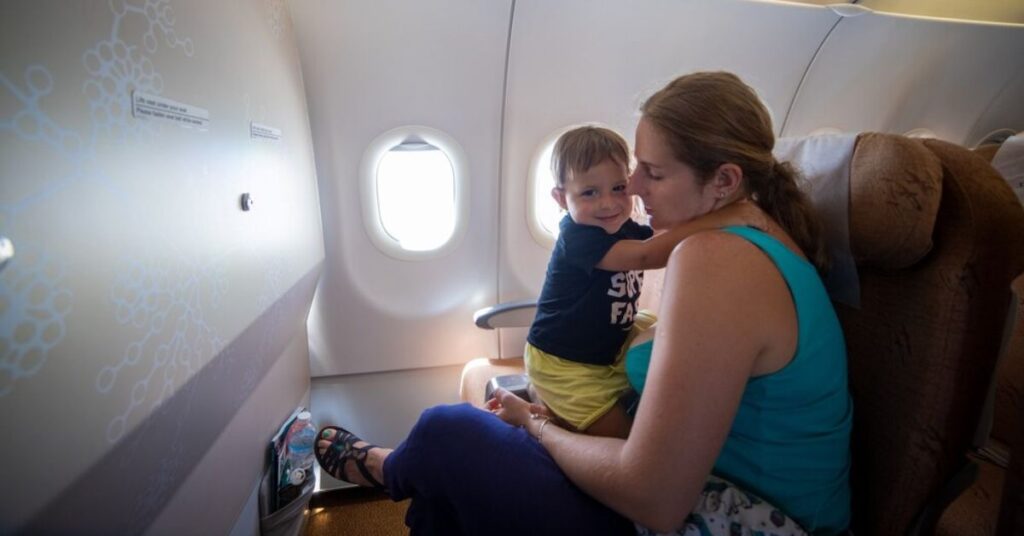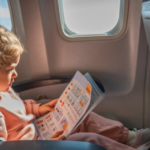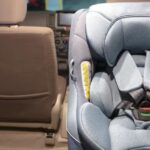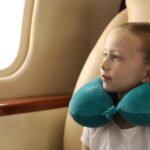Last Updated on April 24, 2025 by Muhammad Sohaib
With a toddler, flying can be both thrilling and intimidating, particularly if you don’t know how to put a car seat on an airplane. For parents traveling with a 3-year-old, ensuring a safe, comfortable flight starts with securing the right FAA-approved car seat and installing it correctly.
This in-depth guide walks you through everything you need to know — from choosing the right airplane-compatible car seat to step-by-step installation tips, airline rules, and pro-level hacks for hassle-free travel.
Why You Should Use a Car Seat on a Plane?
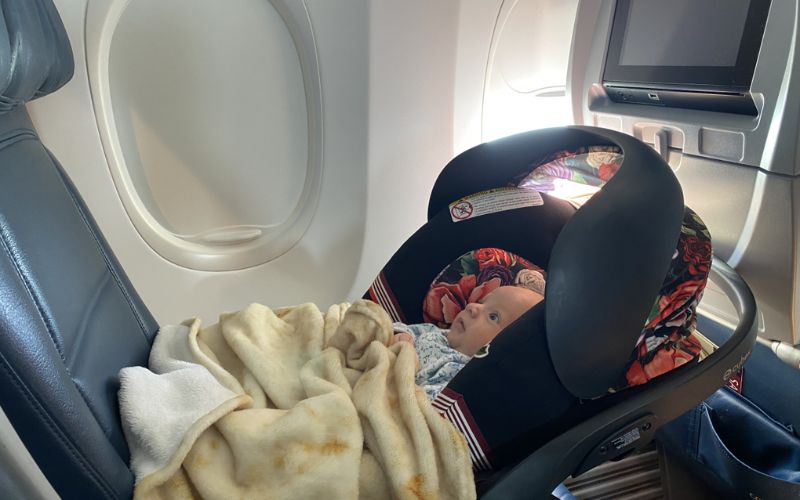
Flying with kids can feel overwhelming, especially for parents traveling with infants or toddlers. Nonetheless, your child’s safety when flying should always come first.
The Federal Aviation Administration (FAA) highly recommends using an FAA-approved car seat to keep your baby secure during flights.
In the event of unexpected turbulence, simply holding your child in your arms may not offer adequate protection. Installing a child safety seat ensures proper infant neck support, reduces the risk of injury, and promotes better baby sleep during flights.
These car seats are especially useful for long-haul flights with toddlers, as they provide comfort, security, and peace of mind for traveling families.
What Type of Car Seat is Allowed on an Airplane?
Not every car seat for air travel meets airline standards, and choosing the wrong one can lead to issues at the gate.
To ensure a smooth experience when flying with toddlers, make sure your travel car seat meets the essential safety and fit criteria:
✅ FAA-Approved Car Seat: Always check for a label that says, “This restraint is certified for use in motor vehicles and aircraft.” This ensures your seat is safe and approved for airplane travel.
✅ 5-Point Harness System: Your seat must have a 5-point internal harness for proper toddler safety. Aircraft are not allowed to use booster seats without this harness.
✅ Compact Car Seat Dimensions: Standard airplane seat width is around 17–18 inches, so your car seat for airplane should be compact enough to fit comfortably.
✅ Lightweight Travel Car Seat: Opt for a lightweight design to make traveling solo with kids easier—especially helpful when moving through airports or installing in tight spaces.
💡 Still unsure which seat is best for your child? Explore our expert recommendations: 👉 Best Travel Car Seats for 3-Year-Olds
Where to Install the Car Seat on a Plane?

When flying with toddlers, always install your child’s FAA-approved car seat in the window seat. This is a standard airline safety rule to ensure there’s no obstruction for other passengers during an emergency evacuation.
🚫 Avoid placing the car seat on an airplane in these spots:
- Aisle seats: These block quick access during emergencies
- Exit rows: Children are not permitted to sit here under FAA regulations
- Bulkhead seats: Only allowed if pre-approved by the airline
✅ Some airlines allow car seats in middle seats (next to the window) if you’re traveling with two kids, giving you flexibility in toddler travel seat arrangements.
Always check the airline’s car seat policy, make sure the car seat is positioned correctly, and verify the airplane seat dimensions before your flight.
Correct positioning boosts child travel safety, helps meet airline regulations, and provides a more comfortable flight experience.
Step-by-Step Guide to Installing a Car Seat on a Plane
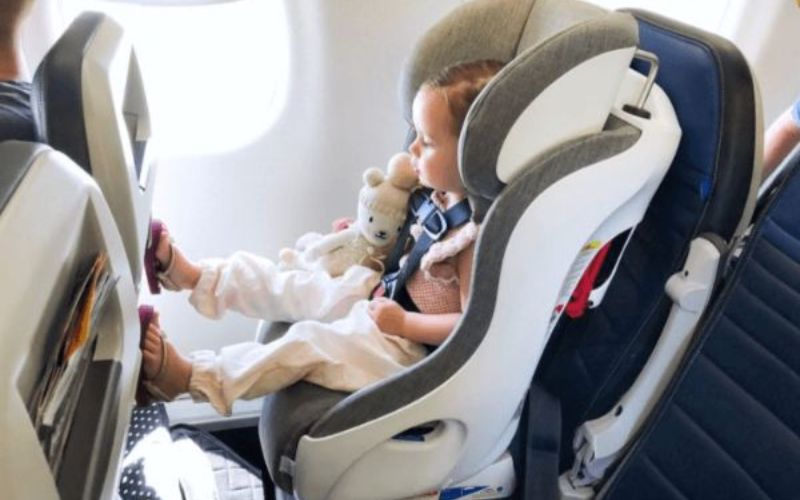
Traveling with toddlers or babies? Ensuring your child’s airplane travel safety is non-negotiable.
Let’s walk through the essential steps and best practices to correctly install a child car seat on a plane, making your journey stress-free and safe.
Step 1: Choose the Right Car Seat for Flying
Not every car seat works on airplanes. Choose an FAA-approved car seat that is
✅ 17–18 inches wide (fits most airline seats)
✅ Has a visible label stating: “This restraint is certified for use in motor vehicles and aircraft”
Step 2: Understand Airline Policies Before You Fly
Before booking, check your airline’s specific child seat policy. Some carriers have strict rules for seat width, seat placement, and installation procedures.
✅ Ask about bulkhead seat use
✅ Confirm if they allow rear-facing installation
✅ Know their car seat guidelines for toddlers and infants
Step 3: Always Install the Seat in the Window Seat
To comply with airline regulations:
✅ Place the car seat in the window seat so it doesn’t block others during emergency evacuation.
❌ Steer clear of exit rows, aisle seats, and bulkhead seats that are not authorized.
Step 4: Use the Lap Belt to Install the Seat
✅ Airplanes don’t have a LATCH system, so here’s how to use the lap belt:
✅ Determine whether the belt path is forward-facing or rear-facing by consulting the car seat manual.
✅ Thread the lap belt through the seat path
✅ Buckle tightly and pull the belt to remove all slack
✅ Ensure that the seat moves no more than 1 inch in any direction.
Step 5: Recline and Adjust the Seat Appropriately
✅ For rear-facing seats, ensure proper recline angle for infant neck support
✅ For forward-facing seats, keep the seat upright for better toddler safety during turbulence
Step 6: Secure Harness Properly
✅ Your child should be strapped in using the car seat’s internal 5-point harness:
✅ Fasten the straps securely at or below the child’s shoulders, ensuring that they face back.
✅ Chest clip should be at armpit level
✅ Make sure the harness is flat, snug, and free of twists.
Step 7: Bring a Car Seat Travel Bag (Optional but Useful)
✅ A car seat travel bag
✅Keeps your seat clean and scratch-free
✅ Facilitates transportation through the airport
✅ Some bags have backpack straps or wheels for convenience
Rear-Facing vs. Forward-Facing Car Seat Installation
When choosing the best car seat for air travel, it’s essential to select the right type based on your child’s age, weight, and height and ensure compliance with both FAA regulations and manufacturer guidelines.
Rear-Facing Car Seats (Recommended for Children Under 2 or Up to 30–35 lbs)
✅ The best choice for young children in the event of in-flight turbulence
✅ Provides optimal infant neck support and spinal protection
✅ Helps babies sleep better in a comfortable reclining position
✅ Often required by airlines for children below 24 months
Forward-Facing Car Seats (Ideal for 3-Year-Olds and Older Toddlers)
✅ Easier to install in compact airplane seats (especially if under 18 inches wide)
✅ It is appropriate once your child has outgrown the seat’s rear-facing limits.
✅ Offers continued five-point harness protection for active toddlers
✅ Works well for kids who need upright posture during long flights
Pro Tip: Always Follow Manufacturer and FAA Guidelines
Every car seat has its own height and weight limits check the label and manual before flying.
Look for the label: “This restraint is certified for use in motor vehicles and aircraft.”
Verify your child fits the car seat’s recommended specifications
Install according to FAA safety standards to ensure compliance and maximum protection
Pro Tips to Make Travel Easier with a Car Seat
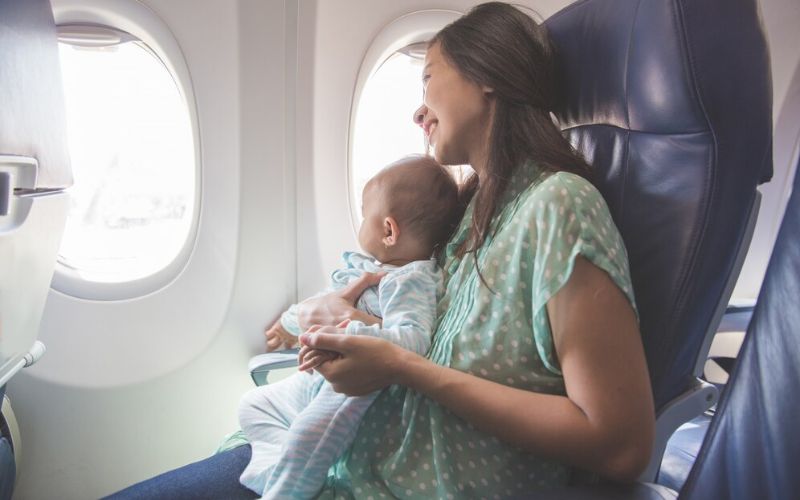
Here’s how smart parents make flying with a toddler a breeze:
🛬 Practice installation at home before your trip. This ensures that your car seat is securely installed and ready, avoiding any last-minute confusion at the airport.
🎒 Use a car seat travel cart or backpack carrier to simplify the process of carrying your toddler’s car seat through the airport. This keeps your hands free and reduces stress.
📲 Download the manual on your phone for quick access in case you need to refer to it while installing the car seat or troubleshooting any issues. This way, you’re always prepared.
🧳 Gate check your stroller and carry the car seat onboard to ensure that both your child’s comfort and safety are prioritized during the flight. This also saves you the hassle of navigating the airport with bulky items.
🕓 Arrive early and use early boarding for families. This extra time allows you to settle in without the rush, giving your toddler some space to get comfortable before takeoff.
These small steps can make a big difference when juggling bags, tickets, and a sleepy toddler at the airport, allowing for a more relaxed travel experience.
By focusing on efficiency and preparation, you can turn the stress of flying with a toddler into a smoother, more enjoyable journey.
Can You Use a Booster Seat on a Plane?
Booster seats are not allowed on airplanes because they require a shoulder belt, which aircraft seats don’t provide. This makes them incompatible with the plane’s seatbelt system, limiting their use during the flight.
If your child is over 40 pounds and no longer fits into a harness seat, they can use the airplane’s seatbelt. However, keep in mind that while the seatbelt provides basic restraint, it doesn’t offer the same level of safety as a 5-point harness system.
Alternatives:
CARES Harness: This is a safe option for children weighing 22-44 lbs, providing secure restraint during the flight, much like a car seat harness, but without taking up too much space.
Booster Seat: If you prefer using a booster seat, you can bring it to your destination. However, it needs to be checked in or carried onboard (but not used during the flight). This allows your child to use it once you reach your destination.
By using the right restraints for your child’s age and size, you ensure their safety and comfort throughout the journey while staying within the airline regulations.
What If Your Car Seat Doesn’t Fit?
If you run into trouble fitting your car seat on the plane, here are some helpful solutions:
- Ask the flight attendant for help: They are trained to assist with seating arrangements and can offer guidance on properly fitting your car seat or help you resolve any issues.
- Consider checking the car seat at the gate: While this is not ideal, it allows you to board without the hassle if the car seat doesn’t fit, ensuring it’s safely transported in the plane’s cargo hold. However, you’ll still have it for your arrival.
- Use a CARES harness: As a backup solution, the CARES harness is a great option for toddlers over 22 lbs and older than 1 year. It provides secure restraint for your child while still complying with the airline’s safety standards.
In the end, a car seat remains the most secure choice, particularly for young children under four. It provides optimal protection and ensures your child is properly secured throughout the flight.
Pre-Flight Checklist: Car Seat & Travel Essentials
Before heading to the airport, it’s essential to ensure everything is well-prepared to avoid any travel hiccups. Here’s a detailed breakdown of the checklist:
✅ FAA-approved car seat with visible label: Ensure that the car seat is FAA-approved and the label is easily visible. This is crucial for a smooth check-in process, as airlines require it to confirm the safety certification for use on airplanes. This will also guarantee safety during your flight.
✅ Car seat travel bag or cart: A travel bag or cart will protect your car seat from damage and make it easier to carry. It’s a must-have accessory for traveling with a car seat, especially in a crowded airport.
✅ Seat width (confirm with airline – most accept up to 17.5 inches): Check the seat width allowed by the airline for the car seat. Most airlines allow car seats up to 17.5 inches wide. This ensures compatibility with airplane seating, preventing any issues when boarding.
✅ Backup harness or airplane seatbelt pillow: A backup harness or airplane seatbelt pillow is a handy alternative for extra comfort and security during the flight, especially if your little one is a restless sleeper or needs more support.
✅ Printed copy or digital version of the car seat manual: Having a manual on hand (either printed or digital) will help in case any questions arise about installation, proper use, or safety features. This is a fantastic method to guarantee mental tranquility.
✅ Extra snacks, books, and toys for toddler entertainment: Keep your toddler entertained and happy with plenty of snacks, books, and toys. This is a simple yet effective way to minimize disruptions and ensure a smooth flight for everyone.
By checking off everything on this list, you’ll increase your confidence and create a more relaxed, enjoyable travel experience for both you and your child. Have a stress-free start to your trip!
Common Mistakes to Avoid
Here are some frequent errors parents make and how to avoid them:
❌ Bringing a non-FAA-approved seat Check the label before flying
❌ Installing in the wrong seat Window only
❌ Using a booster seat Not allowed on airplanes
❌ Although it is legal, it is not safe to skip a seat for a child younger than two laps.
❌ Not tightening the seat enough A loose seat won’t protect your child
Fixing these can improve safety and reduce last-minute stress.
Airline-Specific Rules You Must Know

Not all airlines follow the same procedures when it comes to installing car seats on planes. Understanding these policies ahead of time can save you from last-minute surprises.
✅ 1. Check with Your Airline in Advance
Each airline has its own child seat policy—some may require advance notice, specific seat dimensions, or even restrict rear-facing seats in certain rows. Before you take off, always check the official website or get in touch with customer service.
✅ 2. Seat Placement May Be Restricted
Car seats are not permitted in aisle or exit rows on certain airlines. Most recommend placing them in a window seat so they don’t block access to other passengers.
✅ 3. Approved CRS Only
Make sure your car seat has a “certified for aircraft use” sticker. If it’s not FAA-approved (or EASA-approved in Europe), your airline may not let you use it during the flight.
Also Read: Before You Fly: Know the Rules
Frequently Asked Questions (FAQs)
Can I install a car seat in first class or business class?
Sometimes. Check with your airline some seats may not support proper belt routing.
Do I have to buy a ticket for my 2-year-old to use a car seat?
Yes. If you’re using a car seat, you must purchase a separate seat for your child.
What’s the best FAA-approved car seat for travel?
Check our top picks here: 👉 Best Travel Car Seats for 3 Year Olds
Can I bring the car seat as carry-on?
Yes, if you’re using it onboard. Otherwise, gate check it for free.
Final Thoughts
Using a car seat on a plane is the smartest way to ensure your child’s in-flight safety, comfort, and security. From smoother naps to better containment and fewer tantrums, your trip becomes much easier when your little one is safe and cozy in their own space.
Whether you’re flying for the first time or you’re a seasoned parent traveler, don’t skip this essential step in your family travel checklist.
Want more tips for flying with toddlers or choosing the best travel gear for kids? Visit our blog at MomsChild.com for expert parenting guides, product reviews, and travel hacks!
Image Sources: https://thebabieshq.com, https://www.turtleharbour.org, https://travelingcanucks.com, https://www.which.co.uk
